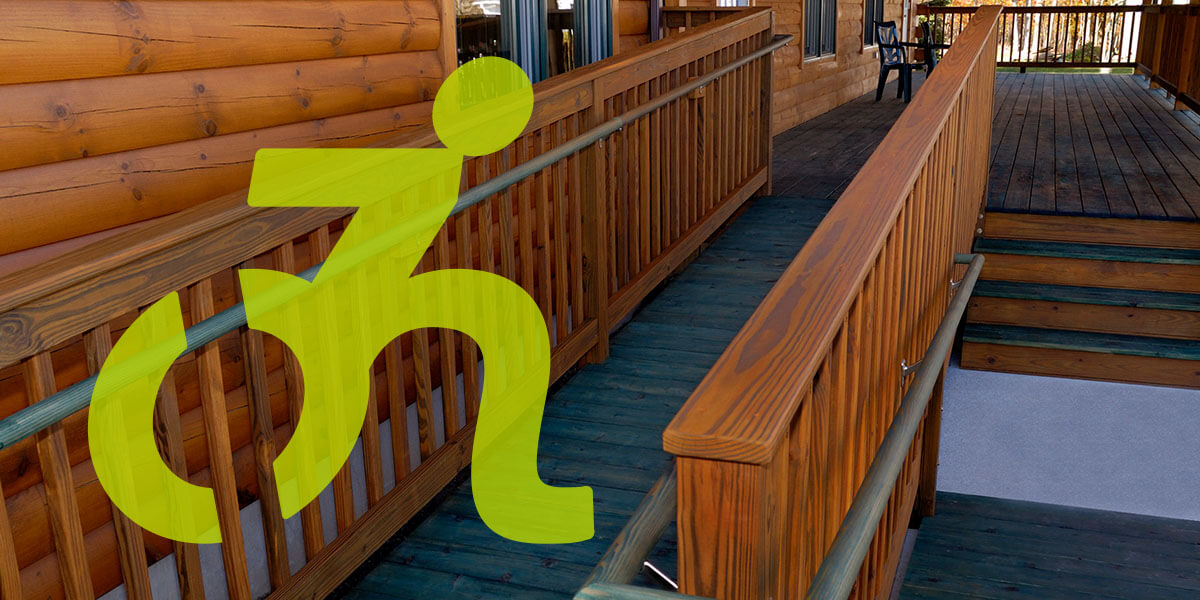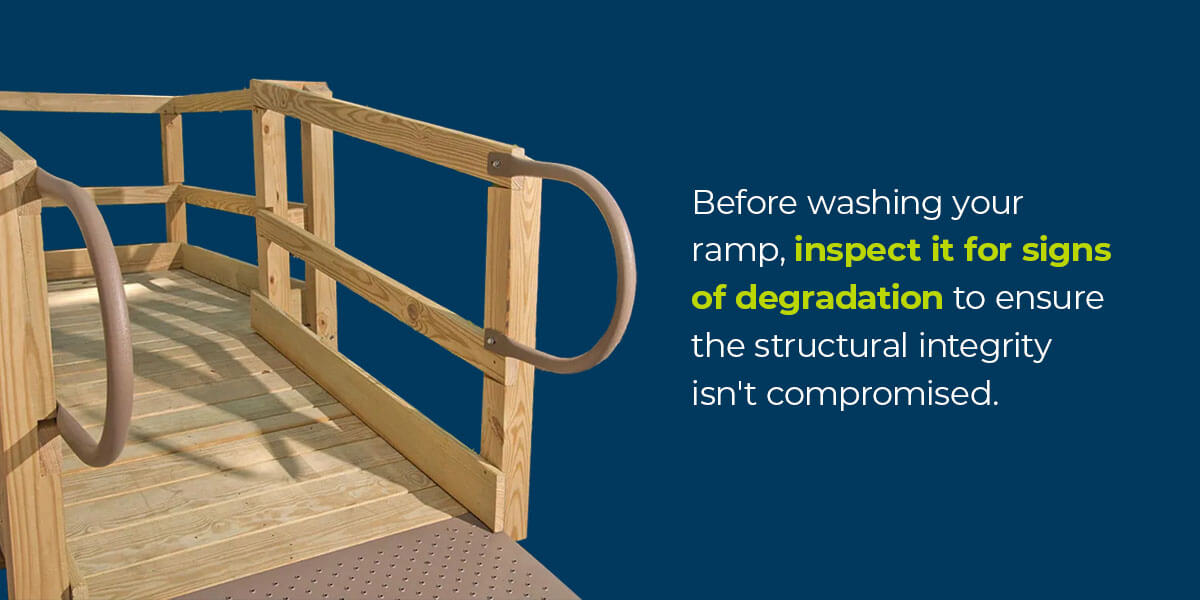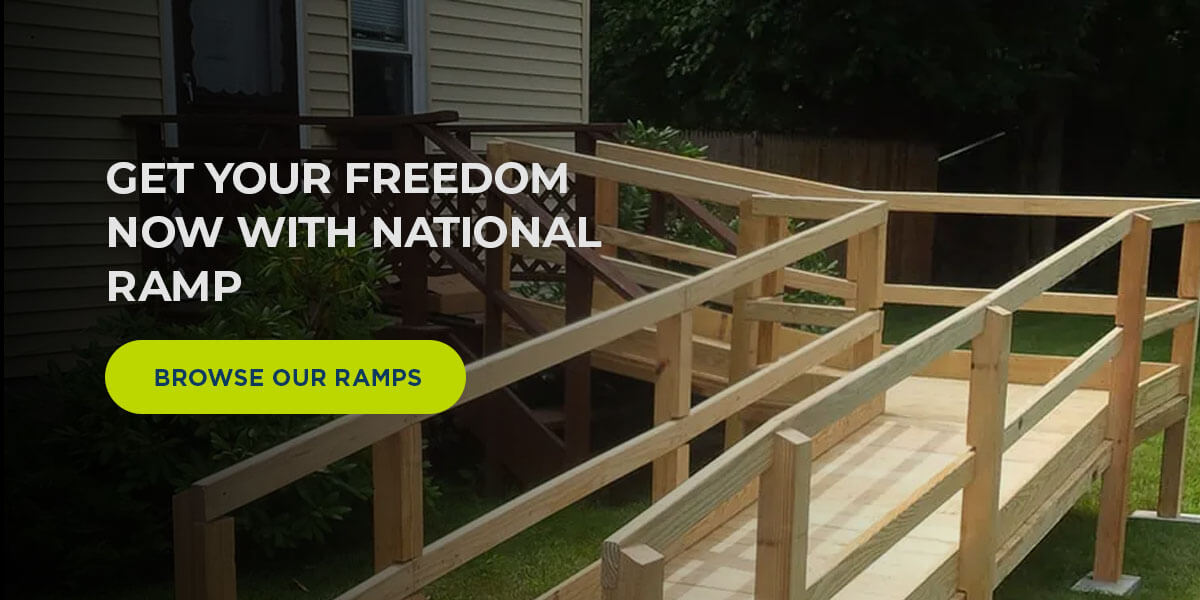
Depending on where you live, rainfall can be frequent, or you can experience snow and ice during winter. These elements can make your wooden wheelchair ramp wet, causing a safety hazard. If exposed to the elements for too long without proper care, moisture can deteriorate your wheelchair ramp to the point where you must replace it.
Fortunately, it’s simple to weatherproof and maintain your ramp to prepare it for winter or heavy rain.
In This Article
- Does a Wheelchair Ramp Need to Be Waterproofed?
- How Do You Seal a Wheelchair Ramp?
- Tips for Protecting and Maintaining Your Wheelchair Ramp
- Get Your Freedom Now With National Ramp
Does a Wheelchair Ramp Need to Be Waterproofed?
There aren’t any specifications in the Americans with Disabilities Act (ADA) about waterproof wheelchair ramps, though most ramps are aluminum or concrete. These ramp materials are durable and weatherproof, so they can withstand the elements and provide long-term accessibility without needing weatherproofing.
Comparatively, you must waterproof your wooden wheelchair ramp, as wood isn’t naturally water resistant. Without waterproofing, your wheelchair ramp will eventually rot from moisture exposure, leading to serious safety issues. if your wheelchair ramp isn’t already waterproof, you should do so promptly to ensure it’s functional for years to come.
How Do You Seal a Wheelchair Ramp?
When you want to protect your ramp from moisture, you must seal and maintain it. Here are the three steps for weatherproofing your wheelchair ramp:
1. Gather Your Materials
Here are the materials you’ll need to seal your wooden ramp:
- Pressure washer
- Exterior wood cleaning product
- Sandpaper
- Wood sealant, paint or stain
- Paintbrush, paint roller or sprayer
2. Clean Your Ramp
In general, you should keep your wheelchair ramp clean. If you allow dirt and debris to build up, it can obstruct access along your ramp and allow residue to accumulate. This residue can trap moisture and cause rot before you can protect your wheelchair ramp from the elements. Further, wood preservatives, stains and sealants only work correctly when the wood is clean.

Before washing your ramp, inspect it for signs of degradation to ensure the structural integrity isn’t compromised. Then, you can use a pressure washer with cleaning or pretreating products to lift grime. To prevent splintering, use the pressure washer on a low setting and gradually work your way up, as needed.
Once the ramp is clean, ensure it’s dry before moving on to the next step. This usually takes a few days of sunshine.
3. Seal Your Ramp
Start by sanding your wheelchair ramp, if needed — sanding ensures the sealant, stain or paint sticks to the wood. Thoroughly clean up any sawdust on the ramp or between the cracks.
Then, you can use a sealer, stain or paint to protect your wooden ramp from ultraviolet light, fungus growth and moisture damage. While sealants are clear coats that protect the wood’s surface from damage, stains block the wood’s pores, and paints coat its surface to offer protection. The choice of which product to use is up to you and the type of wood in question.
Stir your sealant, paint or stain to prevent bubbles. Apply the preservative using a paintbrush, sprayer or paint roller. Keep the coat thin and reapply it at least a few more times once the previous one dries.
Though paints, stains and sealants are effective, they don’t last a lifetime. Over the coming years, you’ll have to reapply the product to ensure your ramp remains protected. Many people reapply the preservative every fall before heading into winter, but you can check the manufacturer’s recommendations on the product you purchase.
Tips for Protecting and Maintaining Your Wheelchair Ramp
Now that you’ve protected your ramp from moisture, you must maintain it to avoid potential damage and ensure it lasts. Check out some tips for maintaining and protecting your ramp regularly and during winter.
Regular Maintenance
Here are some tips for regular maintenance you can complete throughout the year:
- Sweep frequently: Sweeping your ramp prevents leaves, dirt and other debris from accumulating. Even if your ramp has a sealant, you don’t want wet leaves to pile up. Additionally, the accumulation of dirt and debris prevents you from having safe access to your wheelchair ramp.
- Prevent shrubs from growing close to your ramp: When you prevent shrubs from growing close to your wheelchair ramp, you can avoid excess leaves.
- Remove debris from the gaps: You can use a tool like a paint scrapper or butter knife to remove debris from crevices.
- Clean stains and droppings as soon as possible: Ideally, you want to clean stains or animal droppings as quickly as possible, so they don’t settle on your ramp. This effort prevents them from becoming tough to remove and keeps your ramp looking as good as new.
- Inspect your ramp routinely: Ramps deteriorate over time. You’ll want to check for warped and cracked boards, loose or missing nails, discoloration, insect activity, mildew growth and wobbly railings. If you notice any of these signs, address them immediately for your safety.
Winter Maintenance
Because of ice and snow, you must take extra steps to keep your ramp safe, accessible and maintained during the winter:
- Use a thick-bristled broom: You must regularly sweep your ramp during winter to remove dirt and debris. Using a thick-bristled broom can help you clear away snow at the same time.
- Get a snow shovel: A plastic or metal snow shovel will help you quickly clear away snow piles on your ramp.
- Apply snow and ice-melting products: You can use ice-melting products to prevent snow and ice from accumulating on your ramp. Choose a product that’s specific to your ramp’s wooden material.
- Consider using safety accessories: Wooden ramps are particularly slippery when icy, but rubber mats can provide extra traction. You can also use traction paint or strips to prevent slipping.
- Use snow tires: Some companies offer traction wheelchair tires or snow tires, which provide better tracking on uneven surfaces and through the snow.
- Don’t forget about the handrails: The wood’s surface isn’t the only thing that can become slippery — handrails can, too. Before winter approaches, ensure the nails are attached and the screws are tight. You can also apply a melting product to the top of the handrail.

Get Your Freedom Now With National Ramp
You gain your freedom when you have the independence and ability to enter and exit your home whenever you want. For 30 years, National Ramp has helped people regain their freedom with our high-quality, ADA-compliant ramps.
We believe wheelchair ramps are an improvement you can’t wait for — so we don’t make you. When you need a ramp, we install it in days, not weeks or months. This helps you get your independence back sooner.
We have various handicap ramps available, so you can pick whichever best suits your lifestyle and tastes. Browse our wheelchair ramps today or contact us to learn more.
Don’t Risk Injury To You Or A Loved One
Why wait? Give us a call at 877-596-7293 or contact us online to get started!